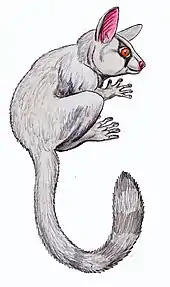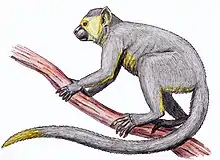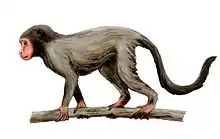| Killikaike Temporal range: Early Miocene | |
|---|---|
 | |
| Scientific classification | |
| Domain: | Eukaryota |
| Kingdom: | Animalia |
| Phylum: | Chordata |
| Class: | Mammalia |
| Order: | Primates |
| Suborder: | Haplorhini |
| Infraorder: | Simiiformes |
| Family: | Cebidae |
| Subfamily: | Cebinae |
| Genus: | †Killikaike Tejedor et al., 2006 |
| Species: | †K. blakei |
| Binomial name | |
| †Killikaike blakei Tejedor et al., 2006 | |
Killikaike is an extinct genus of New World monkey. The genus includes one species, Killikaike blakei, that lived in Argentina during the Early Miocene.[1]
Killikaike blakei was collected from the Santa Cruz Formation in the far south of Argentina in January, 2005 and the type specimen consists of a remarkably well preserved face. The neurocranium is not present. The specimen was named for the locality where it was found Killik Aike Norte, on the estate of the Blake family.[1]
Perry et al. (2014) considered K. blakei to be a junior synonym of Homunculus patagonicus, which is also known from the Santa Cruz Formation.[2] However, Silvestro at al. (2017) considered Killikaike to be a distinct genus.[3] Kay & Perry (2019) continued to regard the species as synonymous.[4]
References
- 1 2 Tejedor, Marcelo F.; Adán A. Tauber; Alfred L. Rosenberger; Carl C. Swisher III; María E. Palacios (2006-03-27). "New primate genus from the Miocene of Argentina". Proceedings of the National Academy of Sciences. 103 (14): 5437–41. Bibcode:2006PNAS..103.5437T. doi:10.1073/pnas.0506126103. PMC 1459373. PMID 16567649.
- ↑ Jonathan M.G. Perry; Richard F. Kay; Sergio F. Vizcaíno; M. Susana Bargo (2014). "Oldest known cranium of a juvenile New World monkey (Early Miocene, Patagonia, Argentina): Implications for the taxonomy and the molar eruption pattern of early platyrrhines". Journal of Human Evolution. 74: 67–81. doi:10.1016/j.jhevol.2014.03.009. hdl:10161/10782. PMID 25081638.
- ↑ Silvestro, Daniele; Tejedor, Marcelo F; Serrano-Serrano, Martha L; Loiseau, Oriane; Rossier, Victor; Rolland, Jonathan; Zizka, Alexander; Höhna, Sebastian; Antonelli, Alexandre; Salamin, Nicolas (2019-01-01). Savolainen, Vincent (ed.). "Early Arrival and Climatically-Linked Geographic Expansion of New World Monkeys from Tiny African Ancestors". Systematic Biology. 68 (1): 78–92. doi:10.1093/sysbio/syy046. ISSN 1063-5157. PMC 6292484. PMID 29931325.
- ↑ Kay, Richard; Perry, Jonathan (2020). "New Primates From the Río Santa Cruz and Río Bote (Early-Middle Miocene), Santa Cruz Province, Argentina". Publicación Electrónica de la Asociación Paleontológica Argentina. doi:10.5710/PEAPA.24.08.2019.289.



